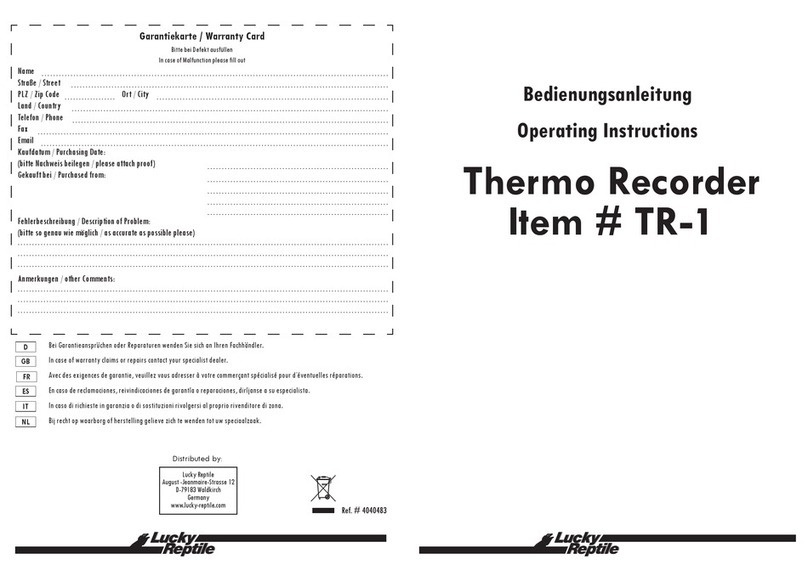
Voraussetzung im Terrarium ist, dass die Tiere sich dem UVB entziehen können, was bei Strahlern wie der
Bright Sun einfach möglich ist, da die UV Strahlung nur punktuell ist. Weiterhin gibt es Untersuchungen, die
zeigen, dass der Körper regulative Mechanismen besitzt, um eine Überproduktion des giftigen Vitamin D3
zu verhindern. Diese Regulierung funktioniert jedoch nur bei einem möglichst natürlichen UV-Spektrum. Bei
der Umwandlung von Prävitamin in Vitamin D3 ist außerdem Wärme nötig. Hier punktet die Bright Sun, da
sie im Gegensatz zu Röhren und Kompaktlampen die notwendige Wärmestrahlung liefert.
Es ist außerdem nachgewiesen, dass sich sowohl die Schädlichkeit von UVB-Strahlen, als auch die Wirksam-
keit für die Vitamin D3-Sythese nur auf bestimmte Bereiche des UVB-Spektrums beziehen und außerdem
innerhalb dieser Bereiche noch extrem verstärkt sein können. Die Bildung von Vitamin D3 ndet z.B. haupt-
sächlich von 280 bis 305 nm statt. Das Optimum liegt bei etwa 295 nm, hier wird etwa 10-mal so viel Prävita-
min D3 gebildet, wie bei 310 nm. Auf Grund der schädlichen Wirkung von kurzwelliger UVB Strahlung sollte
Strahlung unter 290 nm jedoch vermieden werden, auch in der Sonne ndet sich kein UVB unter 290 nm.
Wie keiner anderen Lampen gelingt es der Bright Sun die Sonne zu simulieren. Sie weist eine hohe Lichti-
ntensität und gute Wärmeabgabe auf. Dazu hat sie hohe UVA Anteile und die UVB-Strahlung im richtigen
Wellenlängenbereich für die Vitamin D-3 Synthese.
Bewusst wurde die Strahlungsmenge etwas geringer als die der Sonne gehalten, um die Sicherheit in einem
begrenzten Biotop wie einem Terrarium zu gewährleisten. Dadurch eignet sich die Bright Sun für den Ganz-
tagesbetrieb und ist trotzdem sicher und efzient, um Ihre Tiere mit wichtigem UVB zu versorgen.
UV: Messen und Bewerten
Viele Hersteller geben noch UV-Prozentangaben auf der Verpackung an. Diese geben praktisch keine nütz-
lichen Informationen, ob die Lampe wirklich für Reptilien geeignet ist, da Leistung und bestrahlte Fläche
(Streuung des UV Lichts) nicht berücksichtigt werden. 10% UVB mögen viel klingen aber wenn die Lampe nur
20W hat, dann ist die UVB Menge grundsätzlich schon geringer als 3% UVB bei einer 100W Lampe.
Viele Hersteller sind entsprechend dazu übergegangen mit Mikrowatt/cm2 (µW/cm2) zu werben, wo dann
auch die bestrahlte Fläche berücksichtigt wird. Allerdings sind auch diese Werte irreführend, denn sie sind
abstandabhängig und beziehen sich auf den ganzen UVB Bereich. So ist mit diesem Wert keine Aussage
möglich, ob die Lampe sicher für das Tier oder auch zur Vitamin D3 Synthese geeignet ist.
Genauso sieht es bei Messungen mit Breitband-UV-Messgeräten (z.B. Solarmeter 6.2) aus. Diese Geräte
geben die Energiemenge (µW) an, die eine Lampe im UVB Bereich, also zwischen 280 – 315 nm pro Fläche
(cm2) in einem bestimmten Abstand abgibt. Es wird somit der gesamte Spektralbereich des UVB in der
Berechnung berücksichtigt. Ein solches Gerät kann keine Aussage darüber treffen, welche Wellenlängen
nun genau für die Energie verantwortlich sind, die man mit dem Messgerät misst. So kann es sein, dass die
Lampe nur in einem sehr engen Spektralbereich sehr viel UVB-Strahlung abgibt. Genauso denkbar ist aber
auch, dass der Wert sich aus der Summe kleiner Strahlungsstärken zusammensetzt, die sich über einen
breiten Spektralbereich erstrecken. Viele UV-Lampen zeigen z.B. eine hohe Strahlungsintensität im Bereich
313 nm, wie es für die Emission von Quecksilber typisch ist. Für die Vitaminsynthese ist diese Wellenlänge
nahezu unwirksam, das Messgerät wird jedoch deutliche Werte anzeigen!
Es kommt folglich vor, dass eine Lampe ohne UVB im Vitamin D3 relevanten Bereich von 290-305 nm höhere
Gesamt-UVB-Werte aufweist, als eine gute Lampe mit ausgewogenem Spektrum, die um ein vielfaches ef-
fektiver für die UV Versorgung der Tiere ist.




























